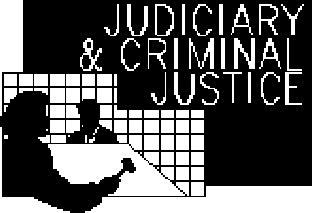
The budget proposes General Fund expenditures of $5.5 billion for judiciary and criminal justice programs in 1995-96. This is about 13 percent of all General Fund spending. The budget proposal represents an increase of $1 billion, or 22 percent, above estimated General Fund expenditures in the current year. The Governor's Budget assumes that the state will receive $422 million in federal funds to offset the costs of incarcerating and supervising undocumented felons in state prison and the Youth Authority. Using the Governor's Budget figures which include this offset, total General Fund expenditures would increase by $630 million, or 14 percent. The large increase in judiciary and criminal justice program expenditures is primarily due to the proposed increase of $606 million from the General Fund for state support of trial courts in 1995-96, which is part of the Governor's state-county restructuring plan.
Figure 1 (see next page) shows judiciary and criminal justice expenditures since 1988-89. Figures for 1995-96 reflect the budget's assumption that the state will receive federal funds to offset costs of handling undocumented felons (we discuss this assumption later in this overview). As the figure shows, expenditures from the General Fund have increased by $2.6 billion since 1988-89, representing an average annual increase of 10 percent. General Fund expenditures decreased slightly in 1992-93, principally because of a significant shift of support for the Trial Court Funding Program from the General Fund to a special fund.
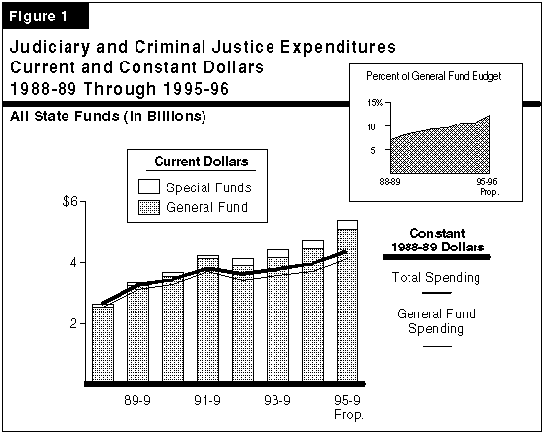
Figure 1 also displays spending when adjusted for inflation. On this basis, General Fund spending increased by an average of 7 percent annually between 1988- 89 and 1995-96. The share of the state's General Fund spending allocated to the judiciary and criminal justice has increased substantially over the same period, increasing from 7.1 percent in 1988-89 to 12 percent in 1995-96.
It should be noted that the federal funds assumed for 1995-96 to cover the state's costs of incarcerating and supervising undocumented offenders are counted as offsets to state expenditures and are not shown in the budgets of the California Department of Corrections (CDC) and the Department of the Youth Authority, or in the Budget Bill. Thus, the Governor's Budget would hold the CDC and Youth Authority budgets harmless should the federal funds not materialize.
Figure 2 shows expenditures for the major judiciary and criminal justice pro grams in 1993-94, 1994-95, and as proposed for 1995-96. As the figure shows, the CDC accounts for the largest share about 61 percent of total spending in the judiciary and criminal justice area.
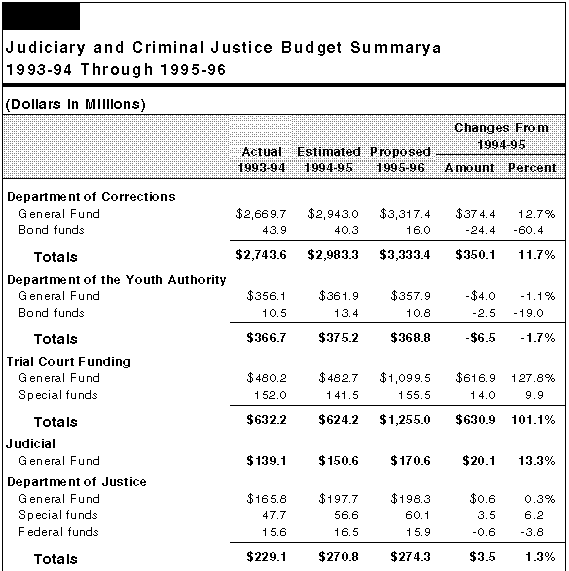

Figure 3 presents the major budget changes resulting in a net increase of $630 million in General Fund spending for the judiciary and criminal justice.
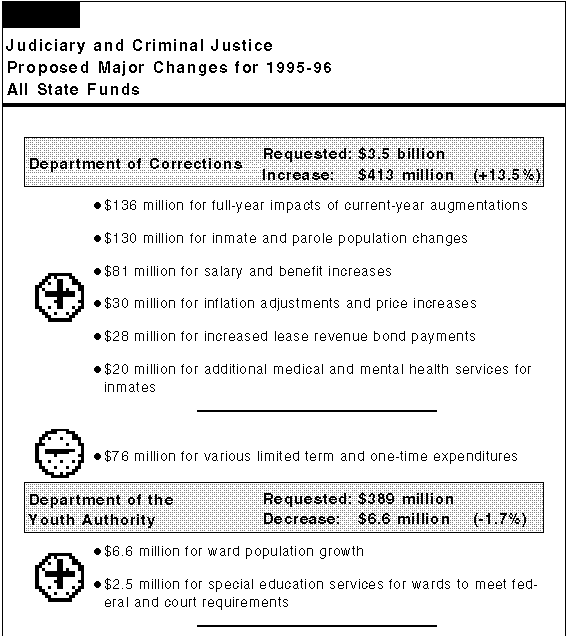
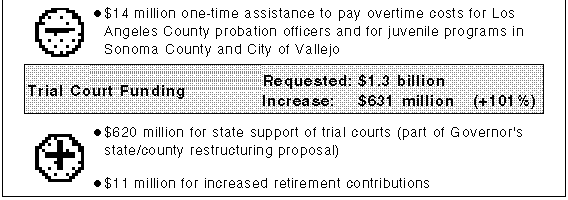
Generally, the major changes can be categorized as follows:
The Budget Proposes to Provide Full Funding for Caseload and Certain Other Cost Increases. This includes funding for projected inmate population increases of 13 percent in the CDC and ward population increases of 8.4 percent in the Youth Authority (including substantial growth as a result of the Three Strikes and You're Out Law). The budget contains no proposals that would result in any significant reductions in the inmate or ward populations.
In addition, the budget proposes to provide full funding for caseload increases in several other judicial and criminal justice programs, such as the Judicial's court- appointed counsel program and the Department of Justice (DOJ) correctional law program.
The budget requires most state departments to absorb the full-year costs in 1995-96 of general salary increases that became effective on January 1, 1995. However, the budget provides augmentations for this purpose to many of the judicial and criminal justice programs such as the Judicial branch, DOJ, and most of the CDC and Youth Authority. This reflects the administration's policy of providing full funding to departments that provide public safety and 24-hour care services. In addition, the budget includes funds for inflation adjustments and price increases in the CDC the only General Fund program that includes such augmentations.
The Budget Proposes a Major Increase in State Funding for Support of Trial Courts as Part of State/County Restructuring Plan. This increase $631 million ($606 million General Fund) is part of a major proposal to provide additional funds to counties in exchange for the counties paying a greater share of costs for various welfare programs (primarily the the AFDC program). In addition, the budget proposes that counties retain approximately $311 million in revenues from fines, fees, and forfeitures that are currently remitted to the state General Fund under the Trial Court Funding Program.
The Budget Assumes Receipt of Federal Funds for Incarceration and Parole of Undocumented Immigrants. As indicated above, the budget assumes that the state will receive $422 million in federal funds in 1995-96 to offset the state's costs to incarcerate and supervise undocumented immigrants in the CDC and the Youth Authority. This is an increase of $389 million over the amount the administration assumes will be available in the current state fiscal year from federal appropriations made for federal fiscal year (FFY) 1995. Based on current federal authorizations and appropriations, however, we estimate that the state would receive only about $245 million in 1995-96.